Discover the delightful flavors of cinnamon raisin sourdough bread with this tried-and-tested recipe. This artisan sourdough raisin bread combines the subtle tang of sourdough with the delicate sweetness of raisins and the warm, comforting notes of cinnamon.
With a golden crust that gives way to a soft, pillowy crumb studded with plump raisins, each bite blends flavor and texture, creating a truly satisfying eating experience.
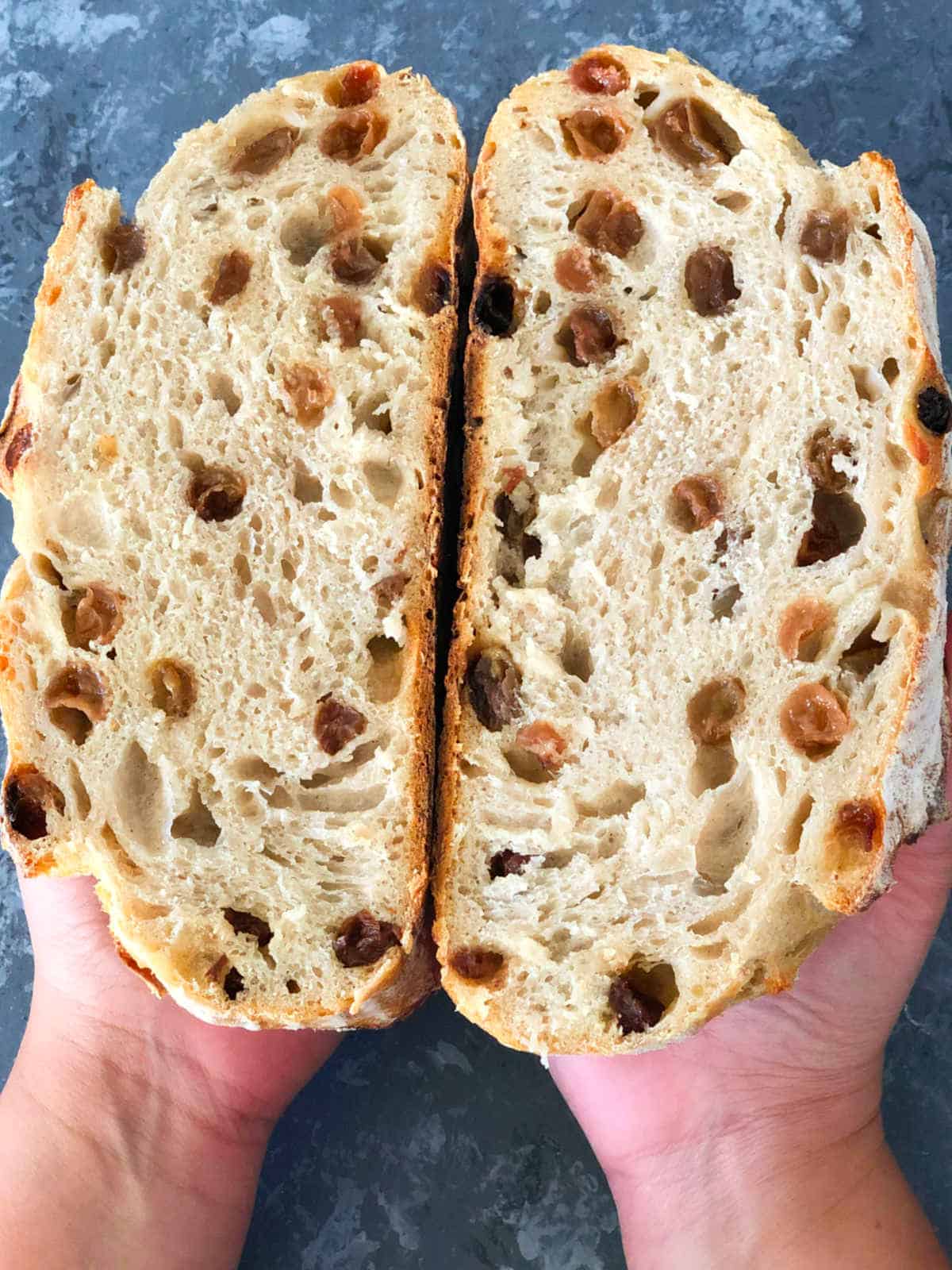
Why you will love this recipe?
- This cinnamon raisin sourdough bread recipe does not have any added sugar for sweetness. Instead, the natural sweetness of raisins is utilized to enhance the flavor profile of the bread. This delicious and unique sourdough bread flavor is a must-try.
- This recipe combines the tangy sourdough flavor with the sweetness of raisins and the warmth of aromatic cinnamon.
- The sourdough starter and fermentation process contribute to a moist and chewy texture in the bread.
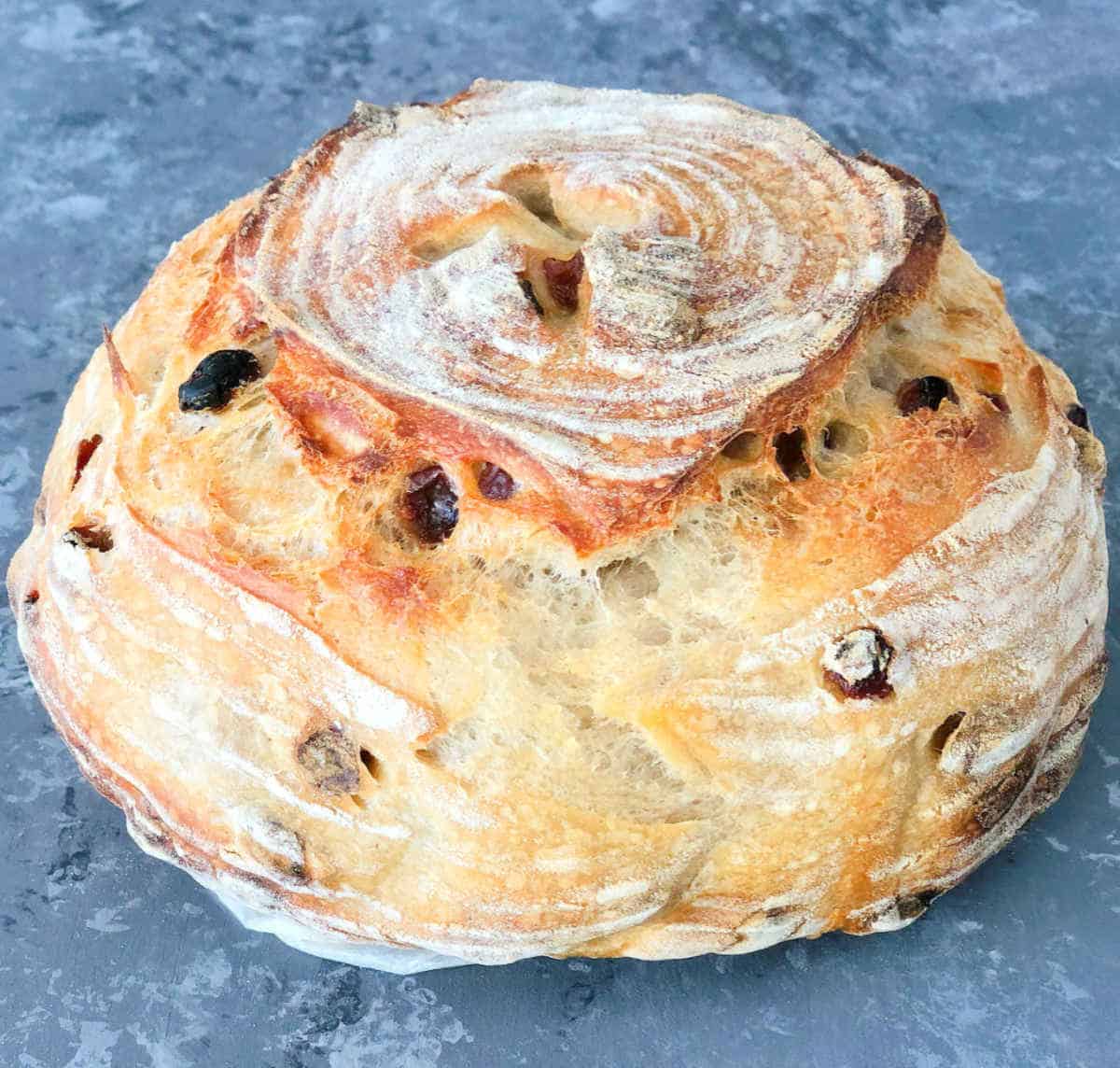
Ingredients
Sourdough starter: Make sure the starter is active and bubbly.
Raisins and ground cinnamon: Soak the raisins in water to ensure they do not dry during the baking process. Adjust the cinnamon as per your preference.
See the recipe card for full information on ingredients and quantities.
Step-by-step instructions
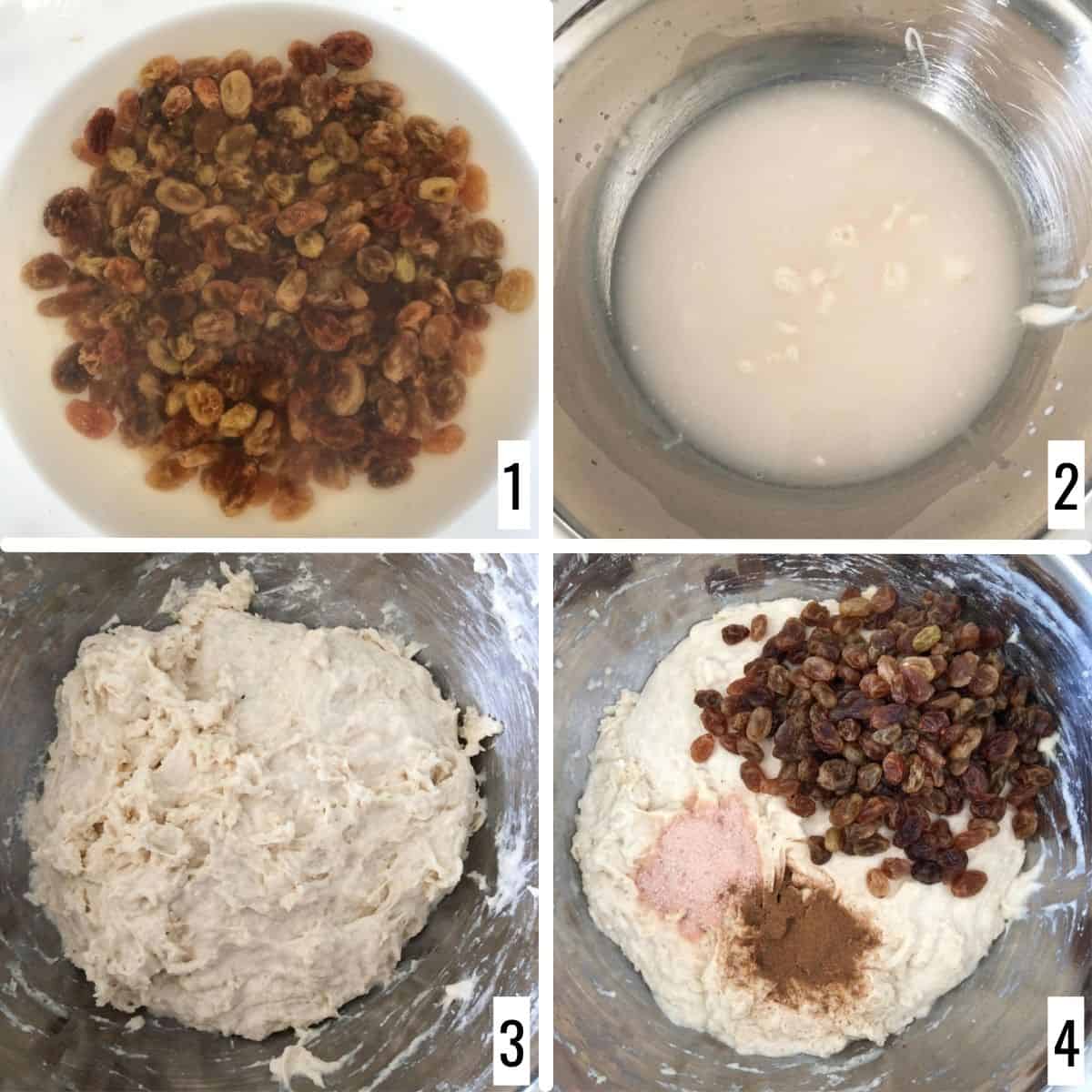
Step 1: Soak the raisins in enough water for 30 minutes to one hour (image 1).
Step 2: In a large mixing bowl, combine the active starter with room temperature water until it is fully incorporated. Slowly add the flour and mix well, making sure there are no dry bits of flour. Let the shaggy dough rest for 30 minutes to one hour (images 2 and 3).
Step 3: Drain the water from the raisins. Add the soaked raisins, cinnamon, and salt to the dough (image 4).
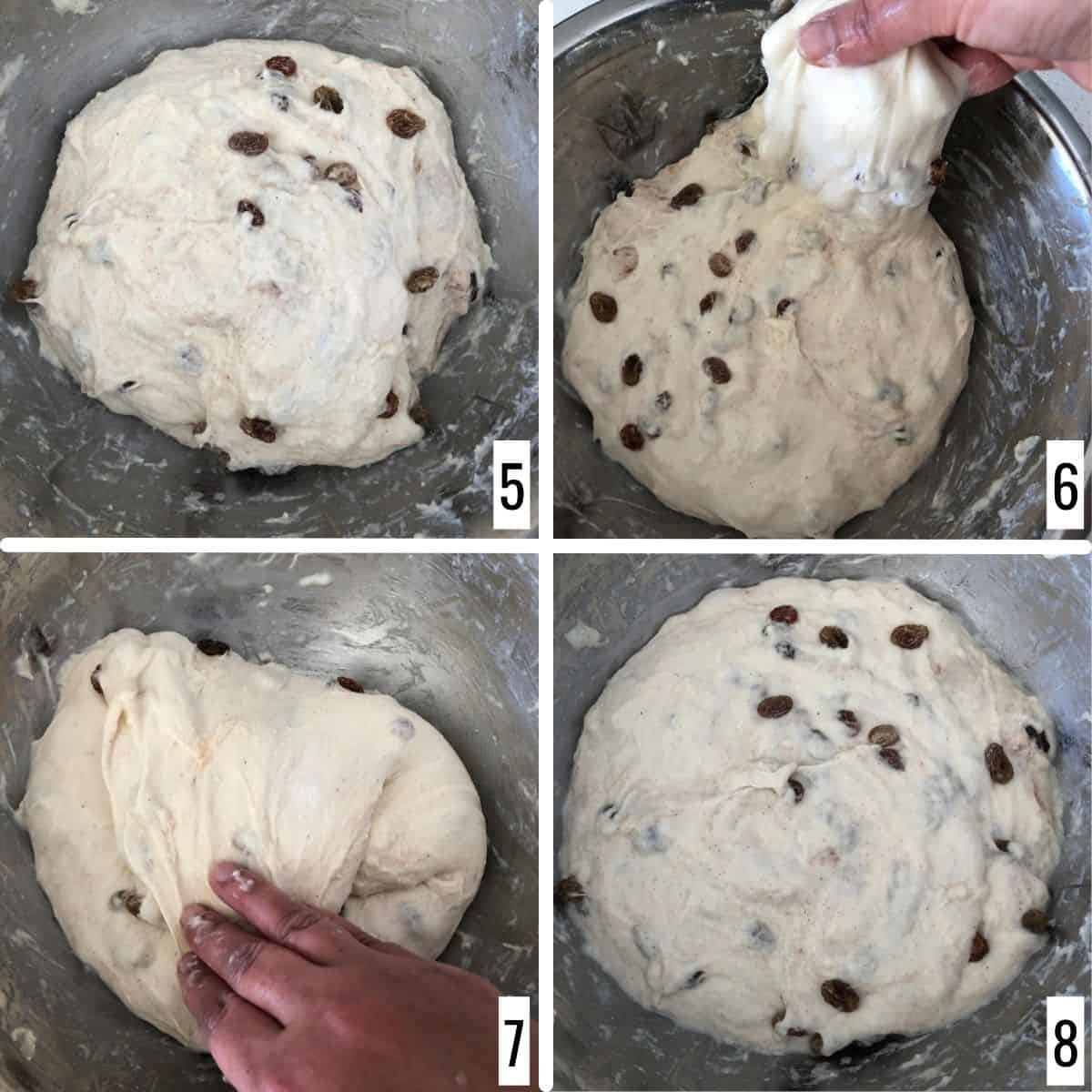
Step 4: Combine well, making sure the ingredients are well incorporated. Let it rest in a warm place for 30 minutes (image 5).
Step 5: Once the dough has rested, gently pull the dough to perform stretch and fold. Gently stretch the sides of the dough and fold it back to the center of the dough (images 6 and 7).
Step 6: Turn the sides of the bowl around and complete the cycle. Let the dough rest for 30 minutes (image 8).
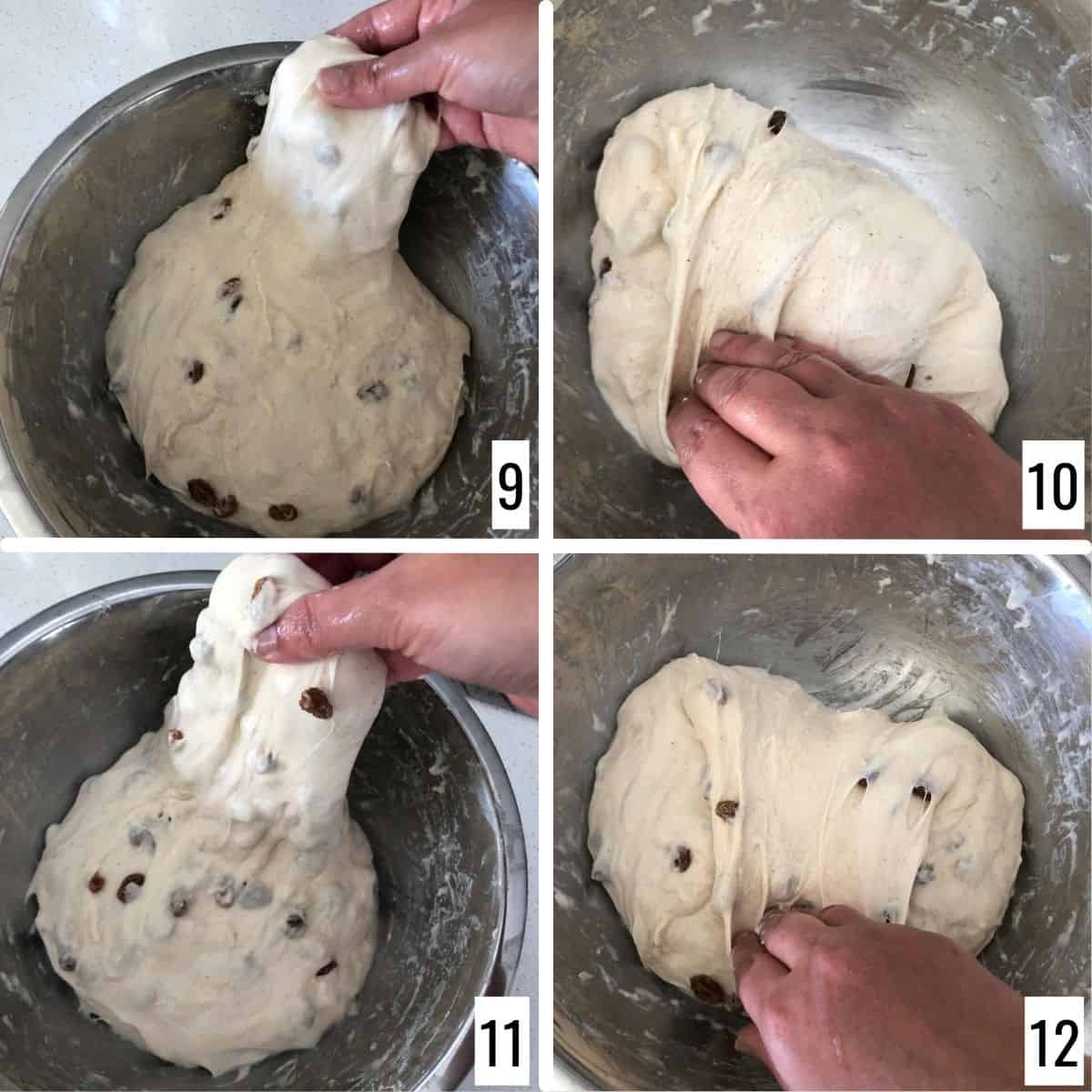
Step 7: Continue to stretch and fold the dough turning the side of the bowl until it develops gluten and builds strength and structure (images 9 and 10).
Step 8: The number of stretch and fold cycles depends on the ambient temperature. Keep working until you begin to see the dough develop a structure (images 11 and 12).
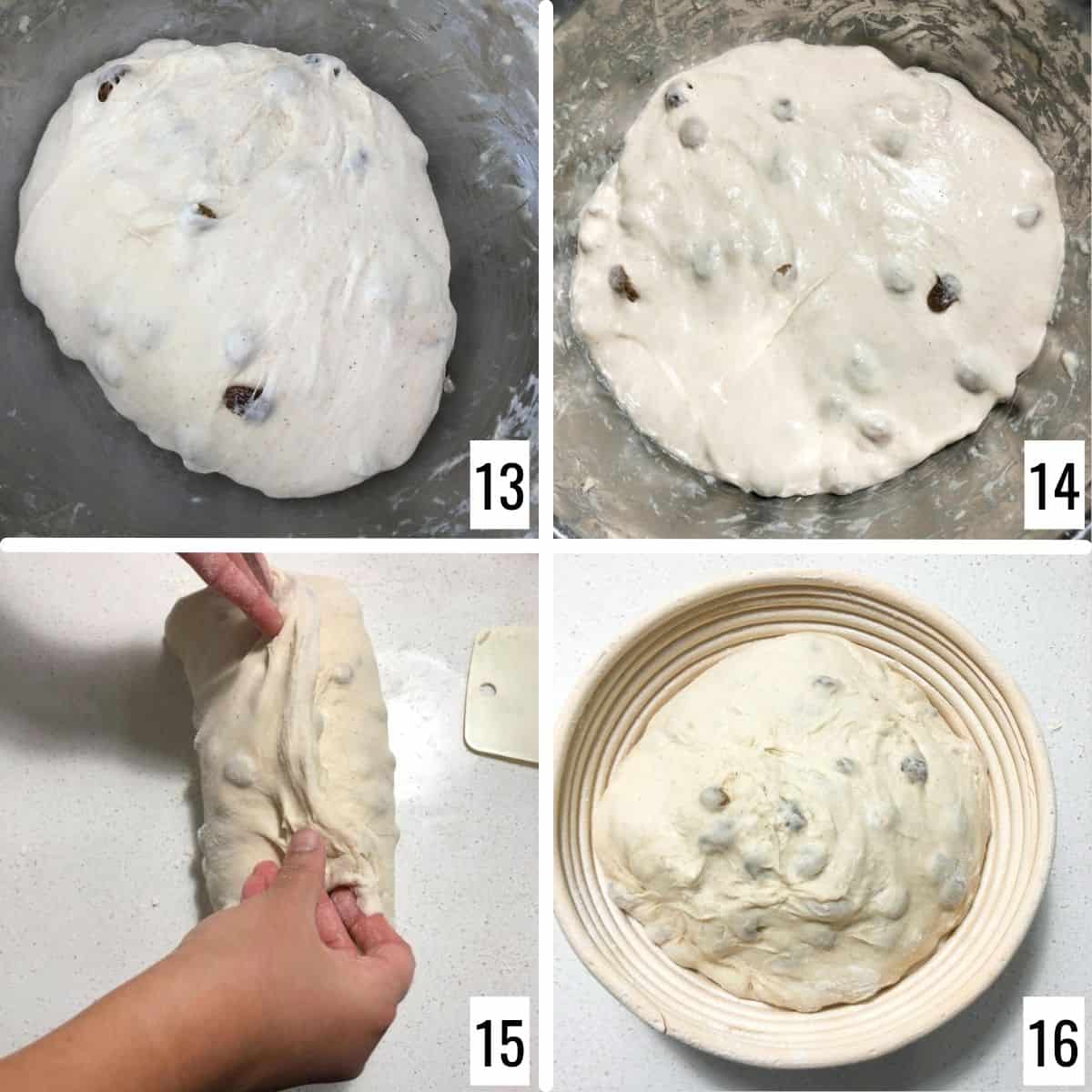
Step 9: Let the dough sit for bulk fermentation (image 13). The dough almost doubles after bulk fermentation (image 14).
Step 10: Flip the dough onto a lightly floured work surface. Pick one side of the dough and fold it to the center. Pick the other side and fold it to the center. Now, hold the dough gently and tuck it to form a log (image 15). Carefully place the dough seam-side up on the banneton. Cover the dough loosely with a damp tea towel or plastic bag. Place it in the refrigerator overnight for cold fermentation (image 16).
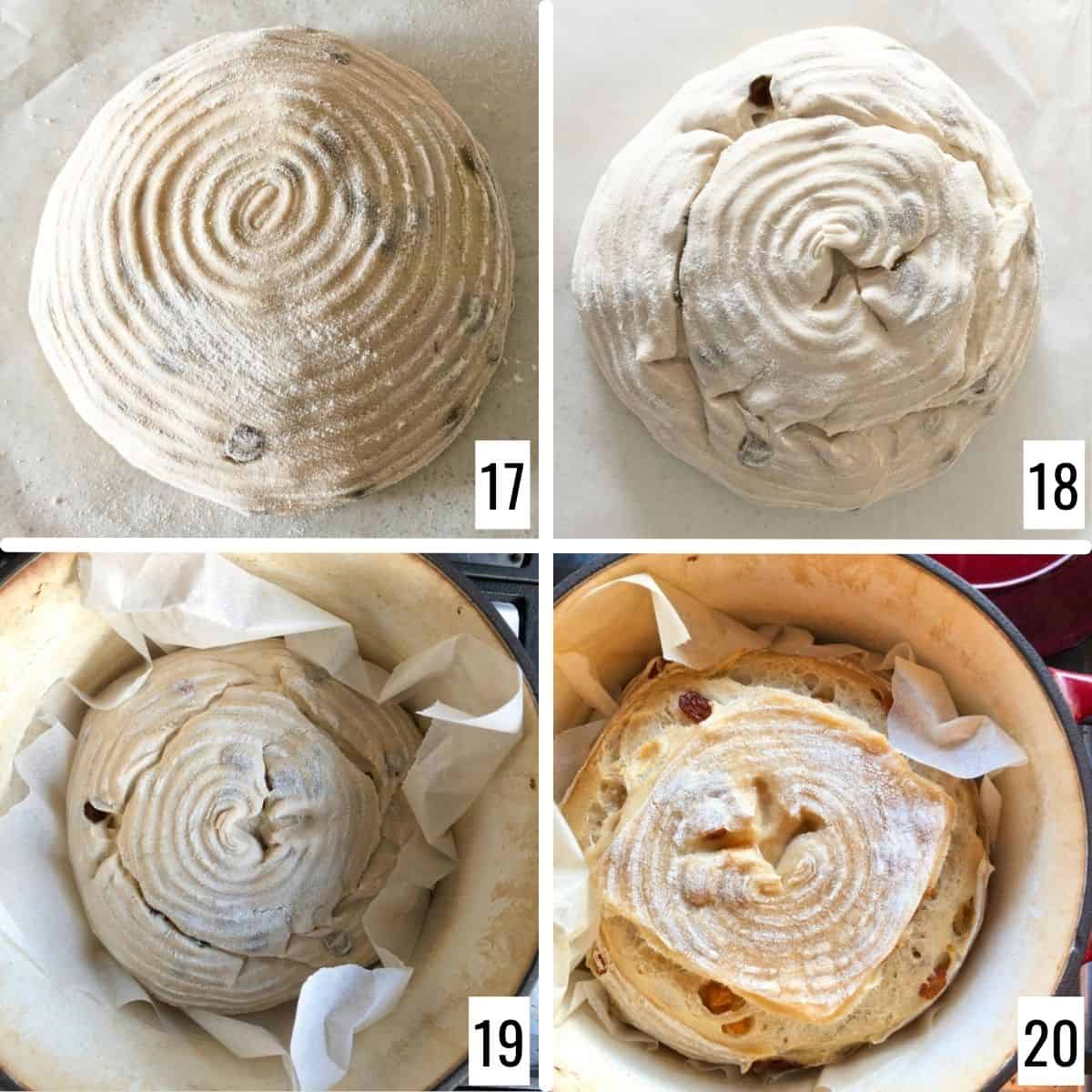
Step 11: The next morning, preheat the oven along with the Dutch oven to 450 F (230 C). Once the oven is preheated, take the dough out of the fridge. Flip it onto a parchment paper or baking sheet. Score the dough using a blade or sharp knife (images 17 and 18).
Step 12: Carefully take the Dutch oven out of the oven. Place the scored dough along with the baking paper into the hot Dutch oven and immediately close the lid. Place it back in the oven and bake for 20 minutes. Take the lid off the Dutch oven and bake for another 15 minutes (images 19 and 20). Cool the sourdough cinnamon bread completely on a cooling rack before slicing.
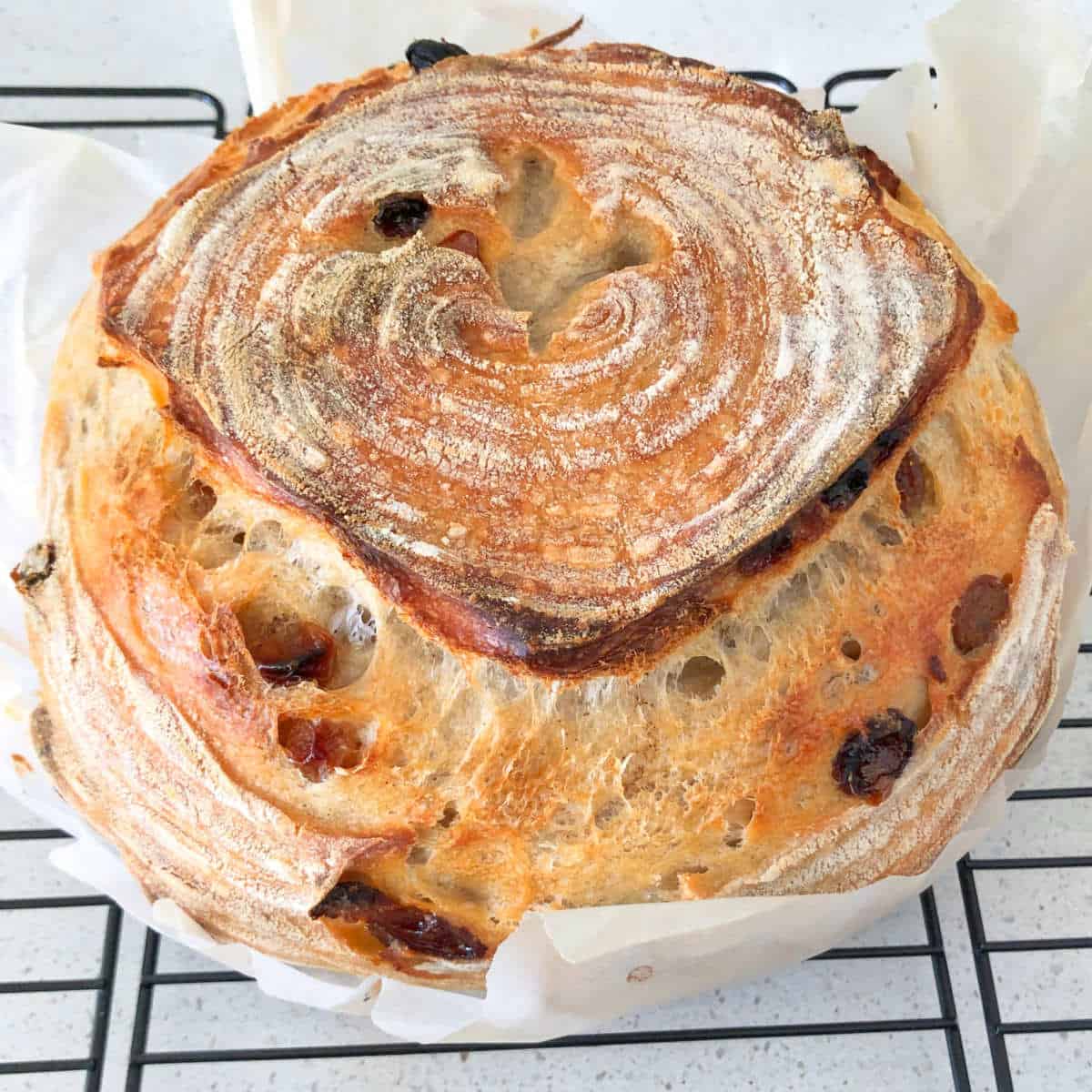
Expert Tips
Ensure that your sourdough starter is active and bubbly before using it in this recipe. The night before you plan to make the dough, take the starter from the fridge and feed it in 1:1:1 ratio of starter:flour:water.
To prevent the raisins from drying out and becoming tough during baking, soak them in filtered water. This will help them stay plump and add moisture to the bread. You can also soak them in some juice if you would like to add more flavor to the raisin bread.
Handle the dough carefully while stretching and folding, given that the raisins may make it slightly tricky to handle. Check out these tips on how to handle sourdough with add-ins.
Cinnamon can slightly slow down the fermentation process and dough rise. Keep an eye on the dough's rise and adjust the proofing time as needed to ensure it has properly risen and developed the desired texture.
How to serve cinnamon raisin sourdough bread?
Toasted: Toast a slice of cinnamon raisin sourdough bread and enjoy it as is, or spread some butter or cream cheese on top. The toasting enhances the flavors and adds a delightful crunch to the bread.
Bread pudding: Tear the bread into chunks and soak them in a mixture of beaten eggs, milk, sugar, vanilla extract, and cinnamon. Bake until the pudding is set and golden brown. You can also use this bread instead of regular bread to make chocolate chip bread pudding.
Snacking: Enjoy a slice of cinnamon raisin sourdough bread as a snack.
Recipe FAQs
Absolutely! If you are not a fan of raisins or would like to try different flavors, you can experiment with other dried fruits like cranberries, currants, or other dried berries. Adjust the quantities to your liking and enjoy the unique flavors they bring to the bread.
Absolutely! The sweetness of the bread can be adjusted to your preference. While my raisin bread recipe does not use any sugar, you can add sugar if you prefer a sweeter taste. Sugar can enhance the overall flavor profile and sweetness of the bread. You can experiment with adding a small amount of sugar, such as granulated or brown sugar, during the mixing stage of your dough preparation. Keep in mind that adding sugar may slightly affect the fermentation process, so monitor the dough's rise and adjust the proofing time as needed.
Start by preparing the dough following the initial mixing and fermentation in the recipe. After bulk fermentation, roll out the dough into a ¼-inch-thick rectangle. Sprinkle a cinnamon-sugar mixture evenly over the dough, then tightly roll it into a log shape. Carefully slice the rolled dough into 1-inch sections to form cinnamon swirls. Arrange them on a baking pan lined with parchment paper. Cover the pan and let the swirls undergo their second rise for 1-2 hours. Preheat the oven to 350 F (180 C), apply an egg wash, and bake for 20-25 minutes until golden brown.
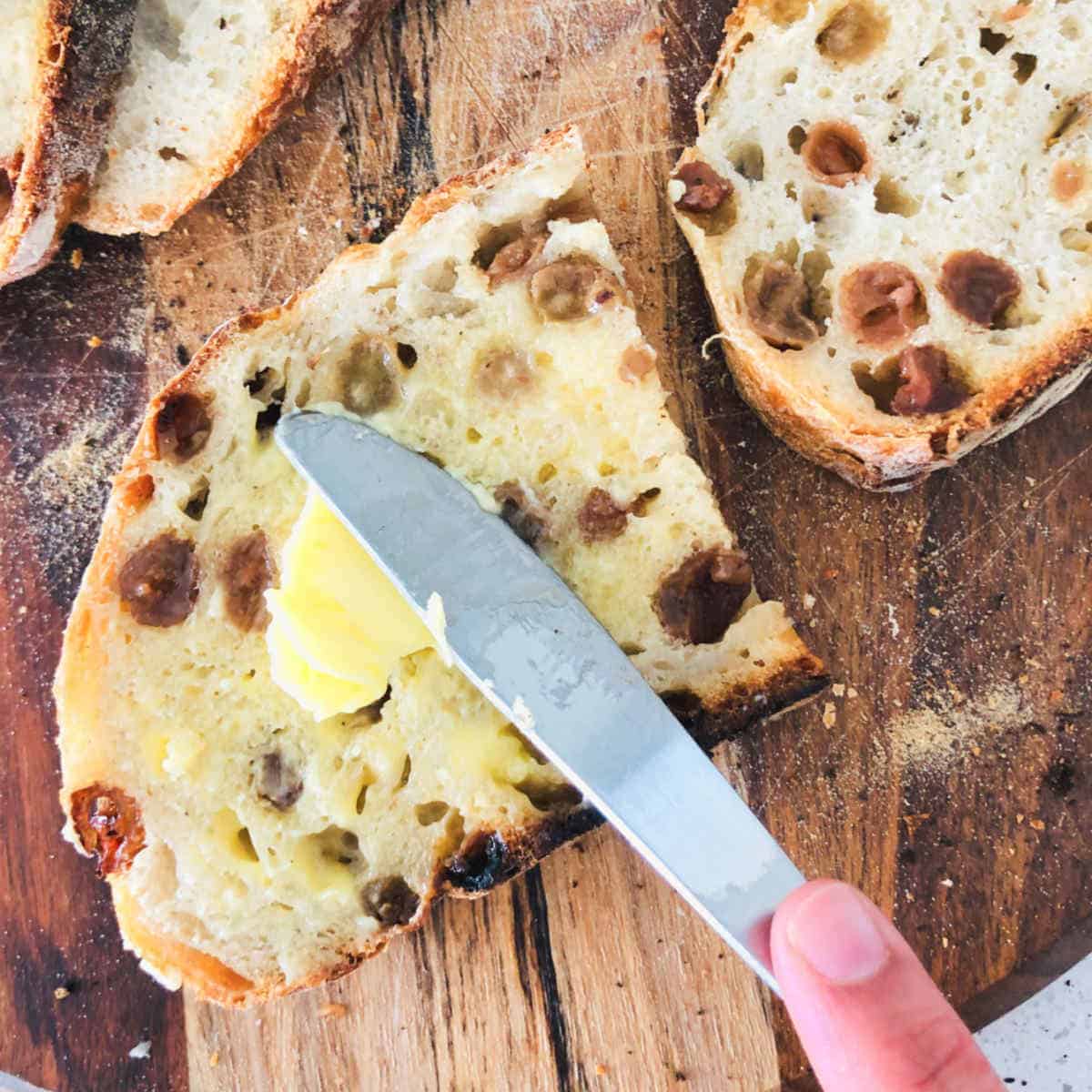
More sourdough recipes
If you tried this Cinnamon Raisin Sourdough Bread Recipe or any other recipe on my website, please leave a ? star rating and let me know how it went in the ? comments below.
Recipe card
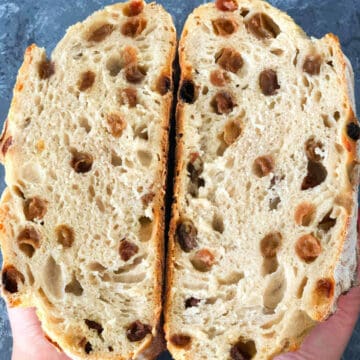
Cinnamon Raisin Sourdough Bread
Equipment
- Bread lame or razor blade to score the dough
Ingredients
- 100 grams sourdough starter active
- 500 grams bread flour
- 375 grams filter water
- 1 teaspoon salt
- 125 grams raisins
- 3 teaspoon cinnamon 1 tsp
- Rice flour to dust the banneton
Instructions
Soak the raisins and make the initial dough:
- Soak the raisins in enough water for 30 minutes to one hour.
- Combine the active sourdough starter with water until it is fully incorporated.
- Slowly add the flour and mix well making sure there are no dry bits of flour. Let it rest for 30 minutes to one hour.
- Drain the water from the raisins. Add the soaked raisins, cinnamon, and salt to the dough. Combine well. Let it rest for 30 minutes.
Bulk Fermentation:
- Perform six sets of stretch and fold at an interval of 30 minutes. With wet hands, grab a portion of the dough and slowly stretch it taking care not to break it, and fold it towards the center over the dough. Keep turning the bowl and repeat the process until all parts of the dough is covered. Carefully flip the dough and round it up. This completes one set of stretch and fold. Repeat this process six times at an interval of 30 minutes.
- Let the dough sit for bulk fermentation until it is almost double and has bubbles on the top. This may take 3-4 hours depending on the ambient temperature.
Shaping and cold fermentation:
- Dust a round or oval banneton well with rice flour.
- Flip the dough onto a lightly floured surface. Pick one side of the dough and fold it to the center. Pick the other side and fold it to the center. Now hold the dough gently and tuck it to form a log. Carefully place the dough seam-side up on the banneton.
- Cover the dough loosely and place it in the refrigerator overnight for cold fermentation.
Bake the cinnamon raisin sourdough bread:
- The following morning, place the Dutch oven in the oven and preheat to 450 F (230 C) for 45 minutes.
- Once the oven is preheated, take the dough out of the fridge. Flip it onto a parchment paper or baking sheet.
- Score the dough using a blade or sharp knife.
- Carefully take the Dutch oven out of the oven. Place the scored dough along with the baking paper into the hot Dutch oven and immediately close the lid.
- Place it back in the oven and bake for 20 minutes.
- Take the lid off the Dutch oven and bake for another 15 minutes.
- Turn off the oven and keep the door ajar. Let the bread sit in the oven for 15 minutes for curing.
- Cool completely, slice, and serve.



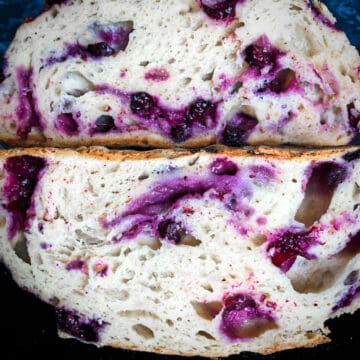
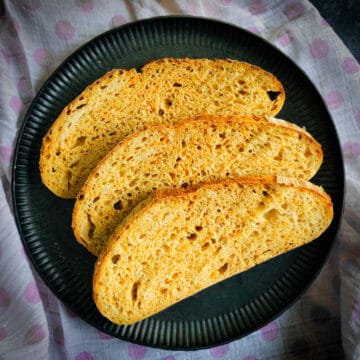
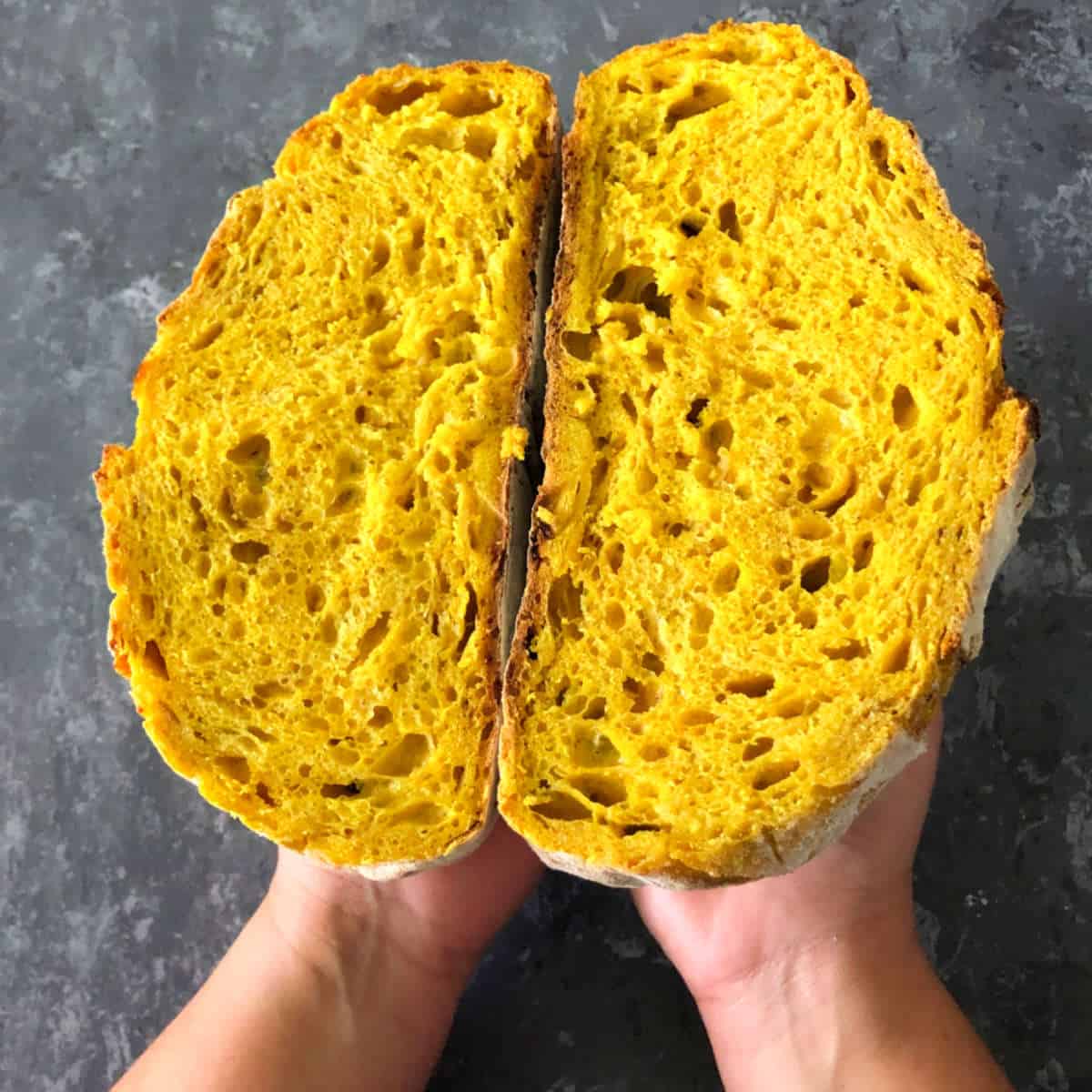
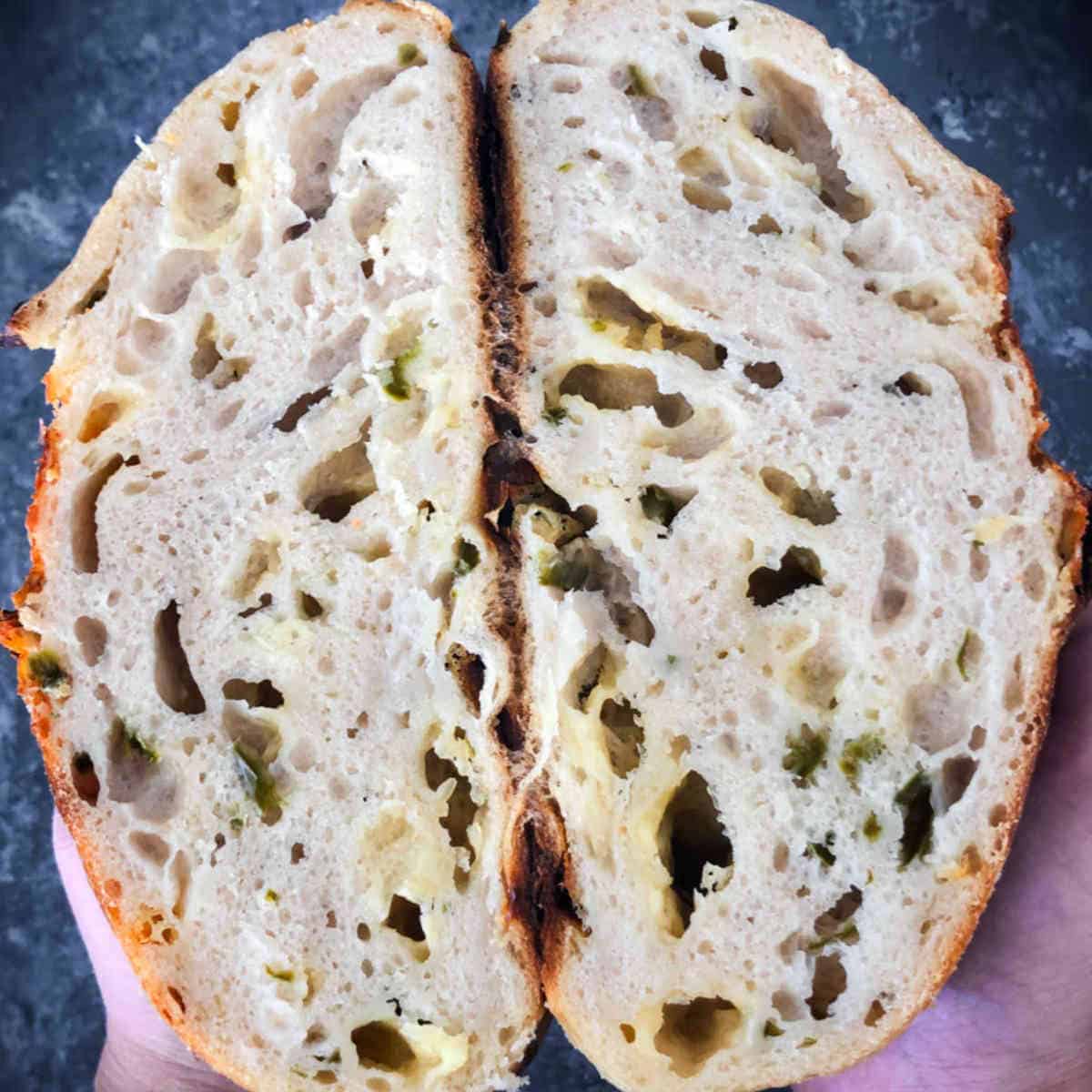
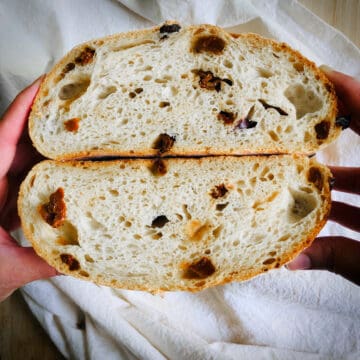
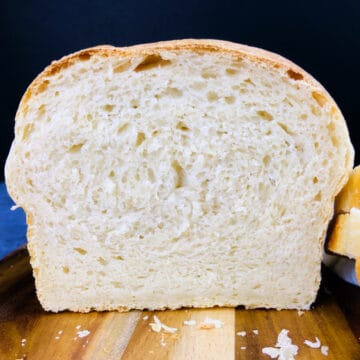
Lea says
This recipe looks wonderful! I have two questions for you: 1. Can I make this into individual dinner rolls (rather than one big loaf)? Should I follow the instructions for making cinnamon whirls as far as shaping and baking goes or should I shape and cold ferment like the regular sourdough? 2. Can I leave out the cinnamon altogether?
Thank you!
Shilpa Kerur says
Hi Lea, Yes, the dough can be shaped into individual rolls and baked, although shaping can be slightly tricky given the high hydration. You can see this post for some tips on shaping and baking times - https://easyindiancookbook.com/sourdough-dinner-rolls/
As for cinnamon, you can skip it but may have to alter the fermentation time. Hope this helps.
I'd love to know your bake results 🙂
- Shilpa
Lea says
Thank you so much for your response! I'm starting to work on it now so I'll let you know how it goes 🙂 One more question: should I let it rise upside down (in the cold ferment part) in small baking pans and then flip it and score it when I bake it (like traditional sourdough), or should I let it rise in the baking pans and just bake directly, without scoring and without flipping it onto a baking sheet (like a dinner roll)? Thank you!
Shilpa Kerur says
You can shape and proof it directly in the baking sheet. When I bake a boule dough into individual rolls, I do it this way and don't score them. Works well and is easier to handle too 🙂